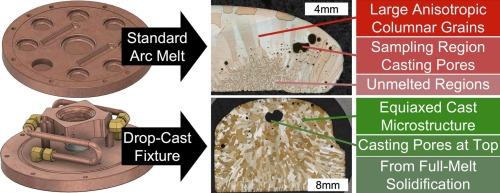Development of a drop-casting fixture to improve microstructure repeatability and data pedigree of arc cast alloy research
IF 4.6
2区 材料科学
Q2 MATERIALS SCIENCE, MULTIDISCIPLINARY
International Journal of Refractory Metals & Hard Materials
Pub Date : 2025-08-18
DOI:10.1016/j.ijrmhm.2025.107386
引用次数: 0
Abstract
Arc cast samples made for alloy development research using a conventional water-cooled copper hearth often exhibit columnar microstructures and some amount of unmelted material, the extent of which may vary from sample to sample or operator to operator. To increase consistency and in turn comparability across different samples and operators, a drop-casting fixture for a non-consumable electrode arc casting furnace was developed to provide repeatable solidification conditions. In comparing the use of the new fixture to a conventional hearth, pure molybdenum castings exhibited more equiaxed microstructures evidenced by circularity measurements of grain cross-sections improving from 0.51 ± 0.03 to 0.67 ± 0.004, and a set of Mo-MoRe alloys showing an average circularity of 0.75 ± 0.008, indicating that an additional benefit is more homogenous, isotropic samples. The equiaxed microstructure repeatability was verified across multiple molybdenum samples and multiple dilute MoRe alloys.

为提高电弧铸造合金研究的显微组织可重复性和数据谱系,开发了一种滴铸夹具
使用传统水冷铜炉为合金开发研究制作的电弧铸造样品通常表现出柱状微观结构和一些未熔化的材料,其程度可能因样品或操作人员而异。为了提高不同样品和操作人员之间的一致性和可比性,开发了一种用于非消耗性电极电弧铸造炉的滴铸夹具,以提供可重复的凝固条件。在与传统炉膛的对比中,纯钼铸件显示出更多的等轴组织,晶粒截面圆度测量从0.51±0.03提高到0.67±0.004,一组Mo-MoRe合金的平均圆度为0.75±0.008,这表明样品更加均匀,各向同性。在多种钼样品和多种稀MoRe合金中验证了等轴组织的重复性。
本文章由计算机程序翻译,如有差异,请以英文原文为准。
求助全文
约1分钟内获得全文
求助全文
来源期刊
CiteScore
7.00
自引率
13.90%
发文量
236
审稿时长
35 days
期刊介绍:
The International Journal of Refractory Metals and Hard Materials (IJRMHM) publishes original research articles concerned with all aspects of refractory metals and hard materials. Refractory metals are defined as metals with melting points higher than 1800 °C. These are tungsten, molybdenum, chromium, tantalum, niobium, hafnium, and rhenium, as well as many compounds and alloys based thereupon. Hard materials that are included in the scope of this journal are defined as materials with hardness values higher than 1000 kg/mm2, primarily intended for applications as manufacturing tools or wear resistant components in mechanical systems. Thus they encompass carbides, nitrides and borides of metals, and related compounds. A special focus of this journal is put on the family of hardmetals, which is also known as cemented tungsten carbide, and cermets which are based on titanium carbide and carbonitrides with or without a metal binder. Ceramics and superhard materials including diamond and cubic boron nitride may also be accepted provided the subject material is presented as hard materials as defined above.

 求助内容:
求助内容: 应助结果提醒方式:
应助结果提醒方式:


